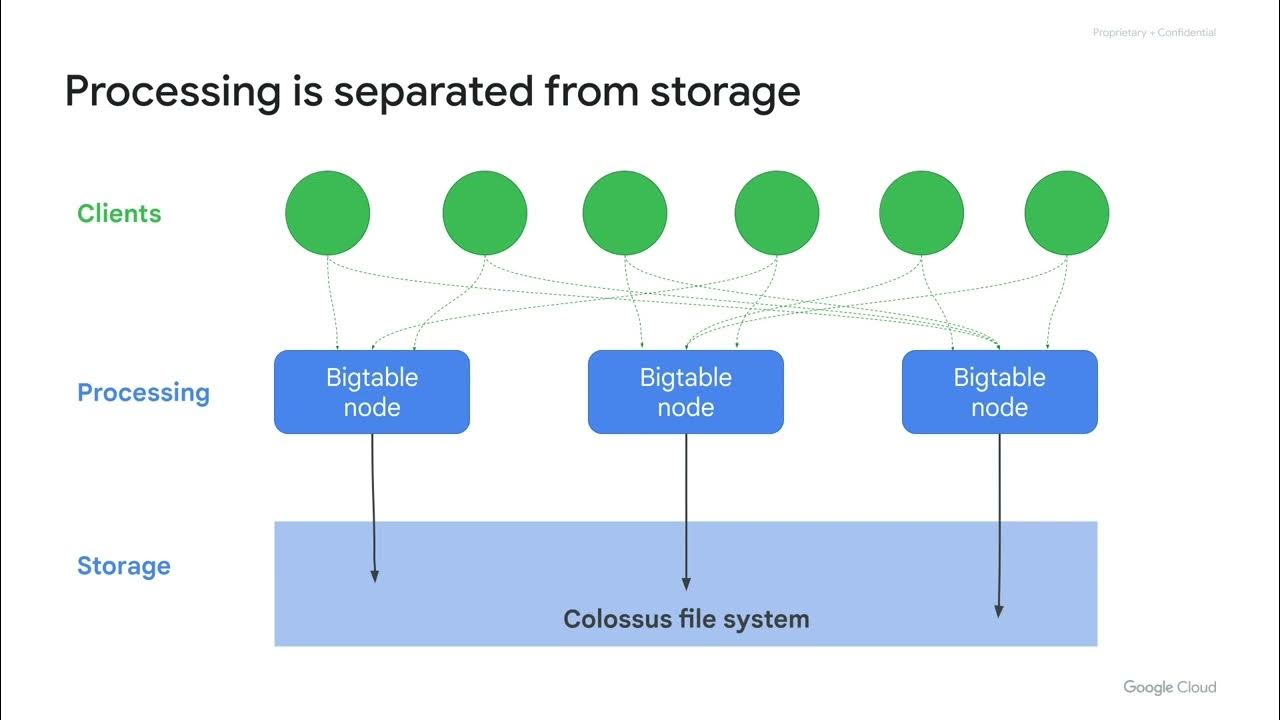Bigtable as a NoSQL option
Summary
TLDRThis module explores Bigtable, Google's NoSQL big data database service, which powers core services like Search, Analytics, Maps, and Gmail. It is designed for handling massive workloads with low latency and high throughput, making it ideal for operational and analytical applications, including IoT, user analytics, and financial analysis. Bigtable is a go-to choice for managing over 1 TB of data, time-series data, and real-time processing. It integrates with other Google Cloud services and supports batch or streaming data processes. Bigtable enables seamless data interaction with APIs, streaming frameworks, and batch processes like Hadoop and Spark.
Takeaways
- 😀 Bigtable is a NoSQL big data database service provided by Google.
- 😀 It powers key Google services like Search, Analytics, Maps, and Gmail.
- 😀 Bigtable is optimized for handling massive workloads with consistent low latency and high throughput.
- 😀 It is suitable for both operational and analytical applications, including IoT, user analytics, and financial data analysis.
- 😀 Bigtable is a good choice for working with more than 1 TB of semi-structured or structured data.
- 😀 It is ideal for fast, high-throughput data or rapidly changing data.
- 😀 Bigtable is typically used for NoSQL data, especially when strong relational semantics are not required.
- 😀 It supports time-series data or data with natural semantic ordering.
- 😀 Bigtable can integrate with other Google Cloud services and third-party clients via APIs.
- 😀 It works well with stream processing frameworks like Dataflow Streaming, Spark Streaming, and Storm.
- 😀 For batch processing, data can be read from and written to Bigtable via Hadoop MapReduce, Dataflow, or Spark.
Q & A
What is Bigtable and how is it used?
-Bigtable is a NoSQL big data database service developed by Google. It is used to handle massive workloads with consistent low latency and high throughput. It is ideal for both operational and analytical applications such as Internet of Things (IoT), user analytics, and financial data analysis.
Which core Google services use Bigtable?
-Bigtable powers many core Google services, including Search, Analytics, Maps, and Gmail.
What are the typical use cases for Bigtable?
-Bigtable is commonly used when handling more than 1 TB of semi-structured or structured data, working with fast, high-throughput data, or rapidly changing data. It's also useful for time-series data, big data processing, machine learning algorithms, and NoSQL data applications.
When should a customer choose Bigtable over other storage options?
-Customers typically choose Bigtable if they are dealing with large amounts of data (more than 1 TB), fast or rapidly changing data, NoSQL data, time-series data, or big data that needs real-time or batch processing.
What types of data can Bigtable handle?
-Bigtable is designed to handle semi-structured or structured data, particularly when data is fast with high throughput, rapidly changing, or in time-series format.
How does Bigtable support data interaction with other services?
-Bigtable can interact with other Google Cloud services and third-party clients through APIs. Data can be read from and written to Bigtable via a data service layer such as Managed VMs, HBase REST Server, or a Java Server using the HBase client.
What is the role of Bigtable in stream processing?
-Bigtable can be integrated with popular stream processing frameworks like Dataflow Streaming, Spark Streaming, and Storm for real-time data streaming. If streaming isn’t an option, batch processes like Hadoop MapReduce, Dataflow, or Spark can be used to interact with Bigtable.
What happens to data after it’s processed by Bigtable?
-After data is processed by Bigtable, it is often written back to Bigtable itself or to a downstream database, sometimes as summarized or newly calculated data.
How does Bigtable compare to BigQuery?
-Bigtable is a data storage service, while BigQuery is a big data analysis and interactive querying platform. BigQuery is used for data analysis and querying, and it is not purely a data storage product like Bigtable.
What are the benefits of using Bigtable for big data?
-Bigtable offers low latency, high throughput, and the ability to handle massive data workloads, making it ideal for big data applications, whether for operational or analytical purposes. It supports both real-time and batch processing.
Outlines

This section is available to paid users only. Please upgrade to access this part.
Upgrade NowMindmap

This section is available to paid users only. Please upgrade to access this part.
Upgrade NowKeywords

This section is available to paid users only. Please upgrade to access this part.
Upgrade NowHighlights

This section is available to paid users only. Please upgrade to access this part.
Upgrade NowTranscripts

This section is available to paid users only. Please upgrade to access this part.
Upgrade Now5.0 / 5 (0 votes)





